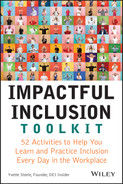ACTIVITY 11
Focus on Ability
“Abled does not mean enabled. Disabled does not mean less abled.”
—Khang Kijarro Nguyen
***
Company leaders are making progress in creating welcoming and positive work environments. As organizations struggle to find talent in many fields, individuals with disabilities are increasingly being recognized as a source of engaged, motivated employees. This focus is long overdue. According to the Bureau of Labor Statistics, 19.1 percent of people with a disability were employed in 2021, up from 17.9 percent in 2020. As we empower people with disabilities to fully participate in a world not designed for them, everyone benefits from their contributions. Like the rest of us, they are unique with a wealth of knowledge, skills, and talents, which adds another dimension of diversity, resourcefulness, and creative energy to the workplace. The Americans with Disabilities Act (ADA) defines an individual with a disability as one who has a physical or mental impairment that substantially limits one or more major life activities. The fact that limitations exist, does not make them any less capable, or prevent them from delivering great work with the use of accessible tools and accommodations. Many have invested most of their lives in creating workarounds so they can comfortably exist and prosper. That vantage point brings fresh perspective and new opportunities. The Society of Human Research Management (SHRM) posted “according to the 2019 Disability Statistics Annual Report from the Institute on Disability, nearly 1 in 8 people in the U.S. has a disability, and that number is rising annually.”
When we have co-workers with disabilities, we must change the way we think about them and challenge our beliefs. According to SHRM, more than 66 percent of workers with disabilities have experienced negative bias. Biased attitudes and the fear of saying the wrong thing creates a barrier to relationship building and causes us to feel awkward when communicating. Awkwardness breeds awkwardness. Before you know it, you and your co-worker are feeling awkward. This is a natural phenomenon when we're not accustomed to interacting with someone who experiences visual or hearing loss, uses a wheelchair, or has Down's Syndrome or some other visible disability. Most often, our first reaction is pity. We applaud them for doing the everyday things that most of us take for granted and tell them how inspirational they are for doing so. Saying things like that comes from a good place; however, it is patronizing. The constant drip of patronizing comments can be devastating. The most important thing to remember when engaging is that they are people, not their disability. The disability is just one of their many characteristics. The more we see the individual, the more we'll realize their capabilities.
Make it a goal to understand the concept of disabilities, as recognized by the ADA. It's helpful to not only be aware of the accommodations set by our organizations but also our role in helping disabled co-workers achieve a sense of belonging. This will take conscious effort as we unlearn and interrupt default patterns. We should be aware of everyday language and avoid using disability metaphors like “lame excuse” or “turning a blind eye.” Learning to adapt to each situation is how we work toward being more inclusive. For instance, you may have to offer a visually impaired person your arm when walking together or let them know when you are leaving the room. Allow them to decide that they need your help. Don't assume. Respect people with disabilities just as you would anyone else. It's the right thing to do. Focus on abilities—what a person can do rather than what a person cannot do. Champions of inclusion acknowledge, understand, and embrace the widespread nature of different abilities while exhibiting comfort over awkwardness when interacting. Attributing value to the lives of others is a gift we can give every day.
Actions
Acquire Disability Etiquette
Etiquette varies by environment and circumstance and is one of the ways we can demonstrate respect for other people. To acquire disability etiquette, check out the following:
CerebralPalsy.org: Disability EtiquetteApa.org: Choosing Words for Talking About DisabilityVantagemobility.com: Disability Etiquette: How to Respect People with Disabilities
Create a Lived Experience
Increase your understanding of people living with disabilities. On your next outing or commute to your place of work, take the handicapped-accessible route—no stairs, no doors that don't automatically open, find street curbs with ramps, etc. Notice the time and energy it takes to get to your destination.
Become an Advocate
Align yourself in support of individuals with disabilities by advocating for a disability-focused affinity group or join an existing one as an ally. Volunteer at an organization that supports individuals with disabilities. Help others acquire disability etiquette.
Welcome Feedback
Be open to in-the-moment advice or coaching from colleagues with disabilities when unintentional slights happen. Ask that they alert you right away as you build your disability etiquette.
Action Accelerators
YouTube.com: If I Can…, Chris Koch, TEDxBinghamtonUniversity:www.youtube.com/watch?v=ftgxQYPWjX8&t=871sMedium.com: “I Don't Want to Hear Your Ableist Slurs Anymore,” by Lia Seth:medium.com/@LiaSeth/i-dont-want-to-hear-your-ableist-slurs-anymore-229538b9fc80JenniferBrownSpeaks.com: “C-Suite 2.0: The Chief ‘Heart' Officer Role and How Empathy Will Fuel Innovative Cultures of Belonging,” by Jennifer Brown:https://stitcher.com/show/the-will-to-change-uncovering-true-stories-of-diversity-and/episode/e38-c-suite-2-0-the-chief-heart-officer-role-and-how-empathy-will-fuel-innovative-cultures-of-belonging-56032184YouTube.com: How to build inclusion into the everyday, Annamarie Jamieson, TEDxAuckland:www.youtube.com/watch?v=ltHMyyfCDqg&t=604s
Sources Cited
- SHRM.org. Attracting and Retaining Workers with Disabilities try this one.
www.shrm.org/resourcesandtools/tools-and-samples/hr-forms/pages/attracting-and-retaining-workers-with-disabilities-.aspx
